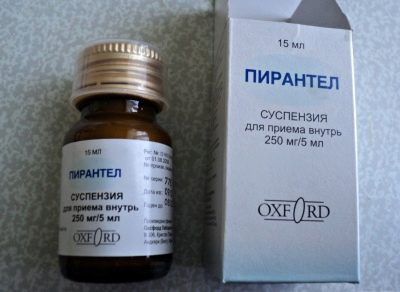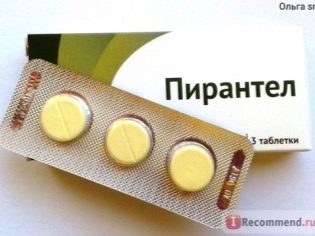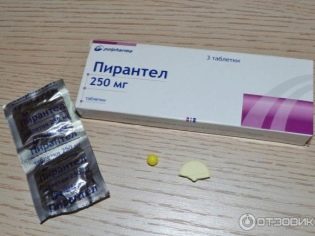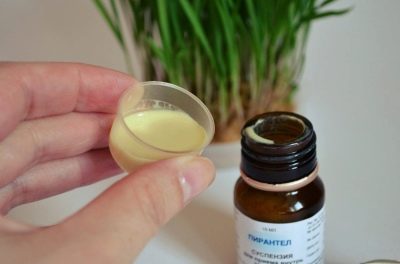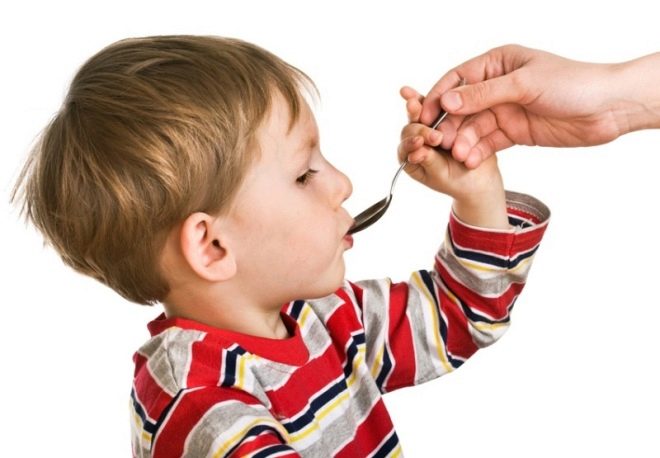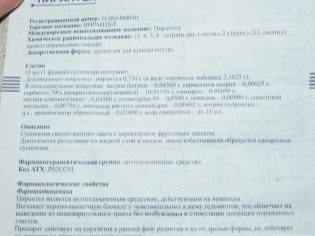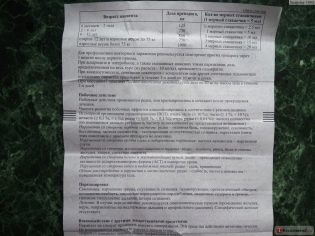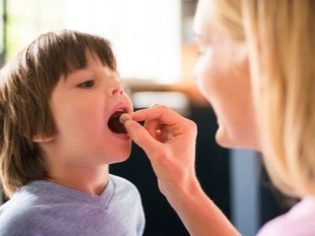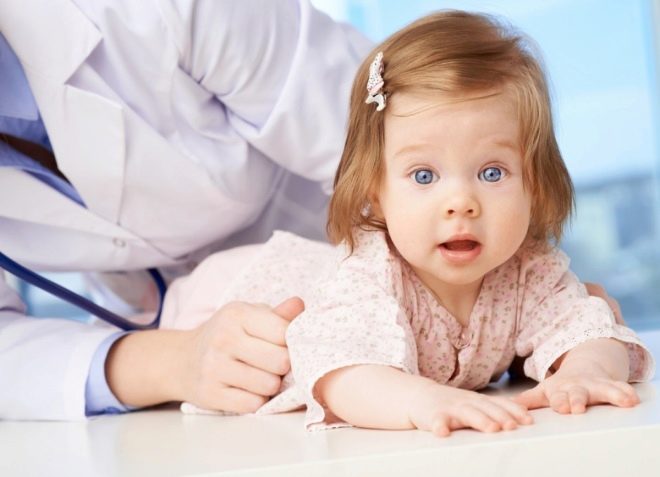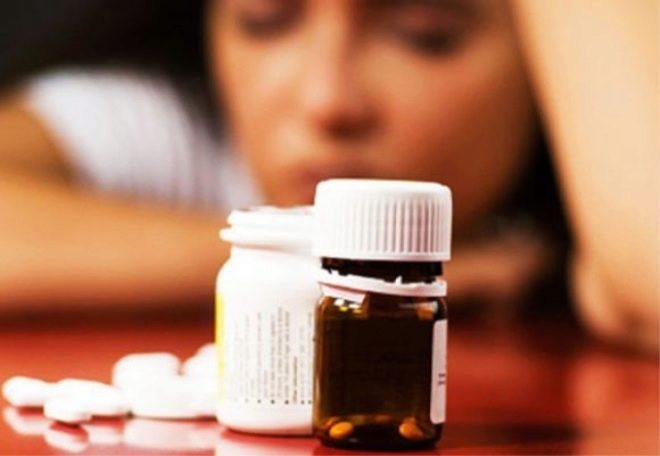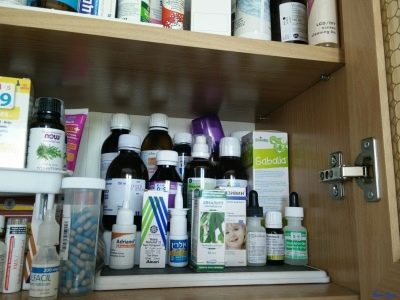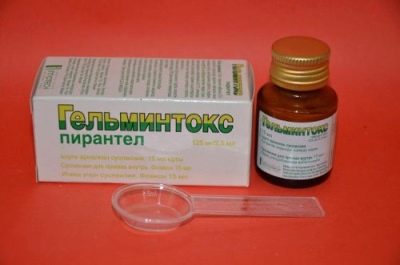Suspension "Pirantel" for children: instructions for use
Helminthiasis is very common in childhood, as babies can eat unwashed vegetables or fruits, drink unboiled water, or lick an object picked up from the ground. The disease is manifested by weakness, impaired stool, nausea, nervousness, frequent colds, headaches and other symptoms, and the analysis of feces helps to identify the cause.
When infecting worms, doctors prescribe special medicines that can kill the parasites and remove them from the children's body. One of them is Pirantel. To make this drug easy to give to children, it is produced in the form of a suspension.. At what age they are prescribed for babies, whether it is possible to give such a medication for prophylaxis and by what means it is replaced if necessary - we will tell about it in this article.
Release form
Pyrantel Liquid is produced by several pharmaceutical companies from Russia, Poland and India. This medicine is a light yellow liquid that has a characteristic odor. The suspension is usually homogeneous, but can be separated into a precipitate and a liquid portion. This is normal, and if the medicine is shaken, it immediately becomes homogeneous.
Depending on the manufacturer, 5, 10, 15 or 25 ml of the preparation can be in one glass bottle. A measuring cup or a measuring spoon of 5 milliliters with a mark of 2.5 ml is often attached to the bottle so that you can accurately measure the right amount of the drug for a particular patient.
In addition to the suspension, Pirantel is also available in tablets containing 250 mg of the active ingredient. These tablets are sold in boxes of 3 pieces, because often this amount of medicine is enough for a course of treatment. In capsules, syrup, ampoules, drops, and other forms, this medicine is not produced.
Composition
The active ingredient of the suspension is called the same as the drug, since it is represented by pyrantel pamoatom. In 5 ml of medication it is contained in an amount of 250 mg, that is, every milliliter of suspension gives the patient Pyrantel in a dose of 50 mg.
So that the medication is liquid, does not spoil during storage and has a sweet taste, glycerol, sucrose, simethicone emulsion, water, sodium benzoate, sorbitol, flavoring and other ingredients are added to it.
Such excipients from different manufacturers differ, therefore, if the child is prone to allergies, it is necessary to specify the composition of the selected suspension.
Operating principle
Pyrantel has a wide spectrum of action on different types of worms. This tool helps to get rid of parasites, causing them to have a neuromuscular blockade.
As a result, paralyzed worms naturally leave the body with feces. At the same time, the medicament does not affect the functioning of the intestines, so the use of Pirantel does not provoke spasms and intestinal obstruction.
The drug effectively affects:
- pinworms - the most common human parasites that cause enterobiasis;
- ascaris - roundworms, which are the cause of ascariasis and parasitic in the small intestine;
- hookworm to duodenal ulcer - round helminth, which is the causative agent of hookworm;
- Ankilostomu New World - a parasite that provokes a disease called nekatorosis;
- Trichostrongilide - roundworms causing trichostrongylosis.
The drug is almost not absorbed in the human intestines, and the part that is absorbed, is partially converted in the liver, so the disease of this organ can affect the treatment of Pirantel.
The drug affects both mature forms of helminths and parasites that have just begun to develop, but the drug does not affect the larvae migrating through the body.
Indications
Pyrantel is used for such helminthic invasions:
- Enterobiasis. This disease is diagnosed in children quite often. Its symptoms include itching in the anus and intestinal disorders.
- Ascariasis. Such widespread helminthiasis is manifested by lethargy, loss of appetite, slight fever, cough, nausea and other symptoms.
- Hookworm infection. With this disease, a child has a skin rash, fever, bloating, nausea, changes in stool and other symptoms of hookworm infection.
- Necatorosis Such helminthiasis is manifested by dyspepsia, an allergic reaction and anemia.
The drug is prescribed both for the detection of worms in the child’s body (if tests have shown the presence of parasites) and for prophylaxis (for example, if worms are found in one of the family members).
At what age is it allowed to take?
Treatment by Pyrantel is not recommended at the age of up to 6 months. For infants of the first months of life, the remedy is prescribed in exceptional cases and only under the supervision of a physician. Patients older than 6 months to six years of age should also be given a suspension. only after a prescription and with increased caution.
If a child is more than 3 years old, he is already allowed the tablet form, but many patients older than three years hardly swallow tablets, so in most cases, even in 4-5 years and older, the doctor prescribes not a solid form, but Pirantel in suspension.
Drug benefits
Doctors distinguish the following:
- the drug acts on the most common types of worms, which are often found in children;
- Pyrantel is called low toxicity, and the effect of the suspension on the digestive tract is less aggressive than that of tablets;
- it is easier for the child to swallow liquid medicine, and thanks to the sweet taste it can be given even to the baby;
- the drug mainly affects the worms and leaves the body naturally during the day, so its tolerance is good;
- as under the action of Pirantel roundworms do not die, taking the medication does not provoke intoxication due to decomposition of killed worms;
- Suspension is affordable and is found in most pharmacies.
Contraindications
The drug should not be given to children with intolerance to Pyrantel or another component of the suspension. In addition, the drug is contraindicated:
- in myasthenia, if such a disease is detected simultaneously with helminthiasis;
- with hepatic insufficiency, since metabolic changes in the absorbed pyrantel take place in the liver cells.
Other contraindications in the annotations to Pirantel are not noted, but if the child has any disease, the use of the suspension should be resolved with the doctor who observes it.
Side effects
The digestive tract of some children reacts to Pirantel diarrhea, loss of appetite, vomiting, abdominal pain and other negative symptoms. Sometimes a suspension can cause a hives, skin rash, or other allergic reaction. In addition, treatment with Pirantel can provoke a rise in temperature or cause undesirable reactions from the CNS, for example, weakness, hallucinations, paresthesias, or headaches.
If the child drank the suspension and he had any adverse reaction, it is worthwhile to show the baby to the doctor.
Instructions for use and dosage
The medicine is taken orally by the following rules:
- The medication is often prescribed once, that is, the dose prescribed by the doctor is drunk at one time. Only in some diseases the drug is drunk for 2-3 days, but this use is permissible only when a doctor is prescribed.
- Before giving the liquid to a small patient, the preparation must be stirred up so that the separated layers are mixed. If the suspension is scheduled for several days, shaking should be carried out before each use.
- The tool is allowed to take at any time of the day. There is no need to drink the medicine on an empty stomach, and also to combine it with laxative preparations.
- Suspension is recommended to give to children during meals or after meals.
- To prevent reinfection, the medication can be taken repeatedly with a preventive purpose 3 weeks after the first use.
- If a child has pinworms, treatment is recommended not only for a small patient, but also for all family members who live with him.
- To make sure that Pirantel acted, some time after taking, you need to pass a control analysis of feces.
The dosage of the suspension in case of enterobiasis or ascariasis for each child is determined individually, since it is different for patients of different ages and for children with different body weights. To calculate the dose, the doctor finds out the weight of the child in kilograms and multiplies it by 10 mg. In most cases, the following standard dosages are used for therapy:
- If the baby is older than 6 months, but he has not yet turned 2 years old and he weighs less than 12 kg, then a single dose of medication will be 2.5 ml. This amount of suspension corresponds to half a measuring spoon or a cup attached to a bottle.
- If a child is from 2 to 6 years old and weighs more than 12 kg, then at one time he is given 5 ml of the drug. This means that the baby must swallow a full spoon or a filled measuring cup.
- If the patient is 6-12 years old, then a single dose for such a child will be 10 ml. The patient is given to drink immediately two measurements of the drug.
- If the child is already 12 years old, then the single dose of suspension he needs is 15 ml (this volume of suspension is contained in three measures).
In cases where ankilostomidosis is detected in a patient, the dosage depends on the severity of the disease and on whether the child is in the endemic zone. If the disease started far away from the endemic zone and proceeds easily, 10 mg of pyrantel should be used for 1 kg of patient weight. In case of severe course or stay in the endemic zone, the dose is increased to 20 mg / kg.
If necatoriasis is detected, a child is also prescribed 20 mg of pyrantel per each kilogram of its weight. In such a daily dose of the drug give 2-3 days. During the day, the drug can be taken once or divided into 2 doses.
For prophylaxis
The use of Pyrantel, as noted above, is possible not only for treatment, but also for prophylactic purposes. Medicine give:
- a child who has been in contact with sick family members;
- babies who were in the forest or other wild environment;
- children who have close contact with animals;
- a child attending a large group, for example, a kindergarten;
- a kid who often plays in the sandbox and is in contact with the soil outside.
It should be canceled that the possibility of prophylactic administration of Pirantel for each particular child should be consulted with the doctor. Typically, the drug is used to prevent helminthic invasion no more than once every 6 months. The drug is given in the dosage that will appoint a specialist.
However, many pediatricians believe that it is not worth drinking an anthelmintic agent for prevention. In their opinion, in order to prevent infection, you should follow the standard rules for the prevention of any infections - maintain personal hygiene, wash vegetables, regularly take tests and so on.
Medications are recommended to give only when the appearance of symptoms of helminthiasis or the identification of worms in the feces.
Overdose
There were no cases when a large dose of Pirantel had a toxic effect. However, if the child drank the drug in a higher dosage than is necessary for his age, it is recommended to induce vomiting and observe the patient, and if symptoms of discomfort appear, immediately seek medical attention.
Interaction with other drugs
Do not use Pirantel together with Piperazin, since with such a combination the effect of drugs will be weakened. It is not recommended to combine Pirantel and other anthelmintic drugs, so as not to increase the load on the liver.
Also, the manufacturer does not recommend the combination of suspension with theophylline preparations, in order not to increase the concentration of this substance in the blood and not to provoke side effects. With regard to other drugs, there is no information on incompatibility with Pirantel.
Terms of sale
Buying a suspension in a pharmacy is possible only if you have a prescription from a doctor, so before purchasing this form of Pirantel, you need to show the child to a pediatrician, a gastroenterologist, or another specialist.
The price of the drug differs from different manufacturers, and also depends on the volume of the suspension in the bottle. For example, the cost of 15 ml of medication varies in different pharmacies from 31 to 65 rubles.
Storage conditions and shelf life
At home, the medicine should be stored at a temperature of +15 to +25 degrees. To store the suspension, choose a place inaccessible to the child, which will be dry and protected from direct sunlight.
The shelf life of liquid Pyrantel is 3 years and is marked on the packaging. If the date has expired, the suspension should be discarded. Giving expired medication to children is unacceptable.
Reviews
On the treatment of helminthiasis in a child Pirantel, you can see a large number of positive reviews, which call this tool inexpensive and effective.
According to moms, the medicine helped get rid of parasites, eliminate abdominal pain, weakness, skin rashes and other symptoms that caused the infection with worms. The advantages of the drug include its liquid form and ease of dosing. Parents also like that in most cases, the drug must be taken once.
As for the minuses, the main disadvantage of Pirantel is its side effects. Mothers noted that after taking the medicine, the child sometimes has a fever, nausea, headache or other negative symptoms. You can also find reviews that complain about the unpleasant taste of the suspension.
Analogs
A drug that contains the same active substance as Pirantel is a French medicine. Helmintox. For children, it is produced in a suspension, represented by bottles with 15 ml of yellow liquid. Each milliliter of this drug contains 50 mg of pyrantel.
Helmintox is also in demand when infected with pinworms, ascaris or hookworms. It is used in the treatment of a child of any age, but in the first year of life is given with caution. It differs from Pirantel not only by other auxiliary components, but also by price, since it costs several times more expensive.
Besides HelmintoxDepending on the type of helminthiasis, the doctor can replace Pirantel with other drugs that can destroy worms. It may be:
- Vermox. Such tablets contain mebendazole and are used from 2 years of age.
- Dekaris. These levamisole tablets are prescribed for children over three years old.
- Nemozol. Such a preparation containing albendazole is represented by a suspension, chewable tablets and coated tablets. It can be applied at any age.
- Vormin. This tableted drug is an analogue of Vermox. Its action is also provided with mebendazole, and it is possible to give medicine to children 2 years and older.
One of these analogues should be selected together with the pediatrician, because such anthelmintic drugs act on different parasites and have their own characteristics of use.Giving these drugs to a child without a doctor is not worth it.
How to detect worms and whether it is necessary to carry out prevention, Dr. Komarovsky will tell in the next video.

